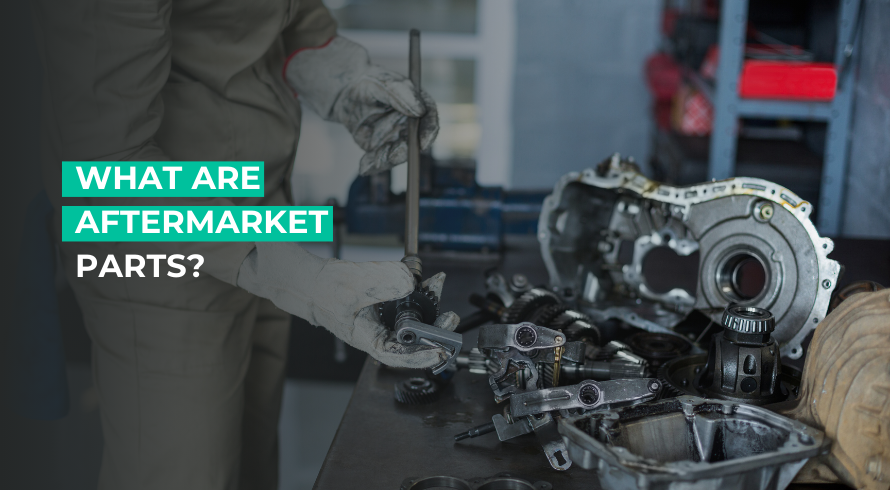Have you ever had your car break down and wondered whether to go with the manufacturer’s parts or explore other options? If so, you’ve probably come across the term “aftermarket parts.”
But what exactly are they, and are they worth it? Buckle up because we’re about to dive into the world of aftermarket parts.
What are aftermarket parts?
Aftermarket parts are replacement car parts that are not made by the vehicle’s original manufacturer (OEM—Original Equipment Manufacturer). Instead, they are produced by third-party companies and are often designed to function the same—or even better—than OEM parts.
For example, let’s say your car needs new brake pads. You can either buy them from the automaker (OEM parts) or choose from a variety of third-party brands that sell compatible brake pads (aftermarket parts). The latter often comes at a lower price and may even offer better durability, depending on the brand.
Advantages of aftermarket parts
Many car owners prefer aftermarket parts over OEM parts for several reasons. Let’s break down the key benefits:
1. Cost savings
Aftermarket parts are often significantly cheaper than OEM parts. This is because multiple manufacturers produce them, leading to more competitive pricing. You could save anywhere from 20% to 60% just by opting for aftermarket parts!
2. More options, better availability
Unlike OEM parts, which are only available through dealerships, aftermarket parts can be found in multiple locations, including auto parts stores, online marketplaces, and independent repair shops. If your car needs a part quickly, an aftermarket option is usually easier and faster to find.
3. Equal (or better) quality
Many people assume that OEM parts are always superior, but that’s not necessarily true. Some aftermarket manufacturers improve upon the original design, making their parts more durable or performance-oriented. For instance, high-performance brake pads from reputable aftermarket brands can outperform OEM versions.
4. Warranty protection
A common concern with aftermarket parts is warranty issues. However, many reputable aftermarket brands offer their own warranties, sometimes even longer than the car manufacturer’s warranty on OEM parts.
5. Customization and performance upgrades
If you’re looking to enhance your car’s performance, aftermarket parts are the way to go. Whether it’s high-performance tires, sportier exhaust systems, or upgraded suspension kits, the aftermarket industry has endless options to modify your ride.
Disadvantages of aftermarket parts
While aftermarket parts have their perks, they’re not always the perfect choice. Here are some potential drawbacks:
1. Quality varies by brand
Since multiple manufacturers produce aftermarket parts, quality can be inconsistent. While some brands offer superior products, others may not meet OEM standards. Always research and buy from reputable brands.
2. Compatibility issues
Not all aftermarket parts fit perfectly like OEM parts. Some may require slight modifications or adjustments, which can add extra labor costs.
3. Warranty concerns
Some vehicle manufacturers may void warranties if you use aftermarket parts. It’s important to check your vehicle’s warranty terms before making a purchase.
4. Too many choices can be overwhelming
While having multiple options is great, it can also be overwhelming. Choosing the right part requires research, and not all car owners have the time or knowledge to compare brands.
How to choose which aftermarket parts to buy
With so many options available, how do you know which aftermarket parts are the right fit for your car? Here are some tips to help you make the best choice:
1. Check reviews and ratings
Look for customer reviews and ratings before purchasing any aftermarket part. Websites like Amazon, AutoZone, and dedicated car forums are great places to read feedback from other buyers.
2. Stick to reputable brands
Not all aftermarket brands offer the same level of quality. Stick to well-known brands that have a strong reputation in the industry, such as Bosch, Denso, ACDelco, and Monroe.
3. Ensure compatibility
Always double-check if the part fits your specific vehicle model. Many online retailers allow you to enter your car’s make, model, and year to filter compatible parts.
4. Compare materials and warranties
Some aftermarket parts use better materials than others. For instance, brake pads made from ceramic tend to last longer than semi-metallic ones. Also, check if the manufacturer offers a warranty for added peace of mind.
5. Consult a mechanic
If you’re unsure about which part to buy, consult a trusted mechanic. They can help you identify high-quality aftermarket parts and avoid potential issues.
The bottom line
So, are aftermarket parts worth it? The answer depends on your needs. If you’re looking for cost savings, performance upgrades, or better availability, aftermarket parts can be a fantastic option. Just make sure to do your research and choose high-quality brands to ensure reliability.
At the end of the day, whether you go OEM or aftermarket, the most important thing is keeping your car running safely and efficiently. Happy driving!
FAQs
How do you manage your auto parts inventory?
Managing an auto parts inventory efficiently requires an inventory management system that tracks stock levels, automates reordering, and prevents overstocking. Many auto repair shops use specialized parts inventory management solution to streamline operations.
How to keep track of parts inventory?
Using real-time inventory tracking and barcode scanning helps auto shops maintain an accurate count of parts. This minimizes errors and prevents lost sales due to missing parts.
What is inventory management in the automotive industry?
Inventory management in the automotive industry refers to tracking, organizing, and controlling spare parts to ensure efficiency. A shop management system helps businesses reduce inventory discrepancies and meet customer expectations without overstocking or understocking.








